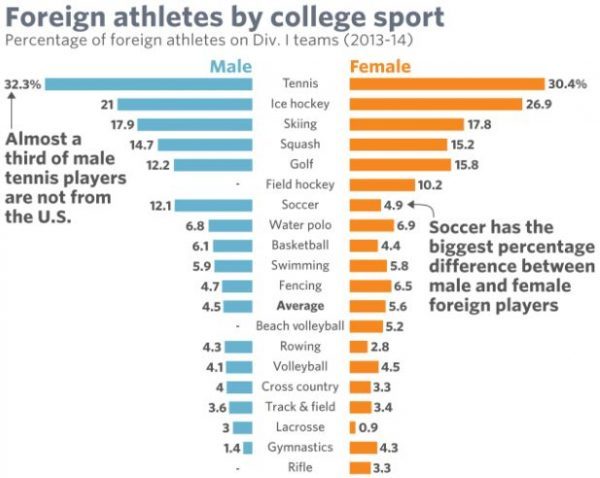College tennis is less American than ever before. The previous statement might sound like a contradiction, but it’s actually true. Sure, matches are still played on campuses within the United States’ boundaries. However, internationals exert a larger impact each season that goes by, not only in terms of roster spot totals but also regarding scholarships.
According to a recent piece published on MarketWatch that cites 2014 data retrieved from ScholarshipStats, tennis is the lone collegiate sport in which foreigners eclipse a 30% participation rate both in men’s and women’s. Ice hockey, skiing, squash or golf also use more than 10% of internationals to fill out their rosters.
Chuck Culpeper wrote a sensational article for The Washington Post noting several reasons behind this ongoing trend. There is no place for xenophobia or protectionism on the tennis courts nowadays. Coaches’ first and foremost priority is to win.
Job (in)security
At some point in the 90s, it became common for universities to reward their athletic departments for their collective success. Some of these bonuses hinged upon the overall performance among all sports. This provoked a domino effect. Athletic directors began demanding positive results from the tennis squads. With the coaches now facing an unprecedented pressure, they started looking for players even at the most remote places on Earth.
“It used to be that to get fired as a tennis coach, when I first started in 1970 at Navy, you had to be guilty of four felonies, had to be on drugs, and running a brothel out of your office, because they just didn’t care,” said Bob Bayliss, a former head coach at Notre Dame.
Currently, a pile of losses is likely to lead toward the exit door.
Internationals grasp college tennis singularity now; it didn’t use to be this way
The 2000 NCAA champion, Alex Kim, believes his foreign contemporaries did not really buy into the uniqueness of college tennis; i.e. they didn’t feel the pride of representing a university.
“While foreigners often had impressive backgrounds and skills, some did not really get into the unique spirit that differentiated college tennis from normal, individual events. They were far from home, and perhaps had less pride than a Texas-born kid who had dreamed of playing for the University of Texas all his life, for example. So at times, playing against a team that had mostly foreigners was sometimes an advantage; you’d get a sense they would more easily fold, taking a ‘who-cares’ attitude.”
Nowadays, if you spend a few minutes browsing through the social media accounts of our VT Sports athletes, you can tell they are fervent fans of their alma mater. Besides, modern day internationals fight for every ball like it is match point, aware of how important that scholarship is in their lives.
The United States no longer dominate the pro tour
Back in the day, America churned out tennis champions at will. They used to all but monopolize the Davis Cup, the Fed Cup and the Grand Slams. Not anymore. If we exclude Serena Williams, arguably the greatest woman to ever pick up a racket, the United States have failed to produce world-class tennis players for a while. Culpeper reminds us that European men have hoisted all 30 major singles trophies in this decade. The latest American titlist was Andy Roddick, when he defeated Juan Carlos Ferrero in the 2003 US Open final.
While not nearly as dramatic, college tennis reflects the current state of the professional circuit. Coaches are looking for international studs and at VT Sports we help you get in touch with them.
Text: Pablo Mosquera

